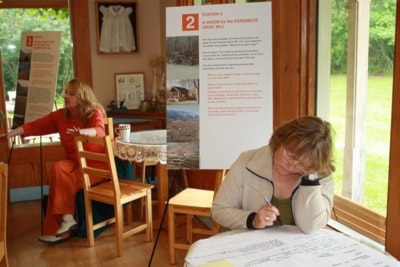The province began its search for a “more sustainable business model” for Keremeos’ historic Grist Mill with a stakeholders workshop held on site on Tuesday, June 26.
The hastily planned meeting attempted to bring all residents with an interest in the heritage site to offer their thoughts on several aspects of the mill’s existance in the Similkameen.
In this year’s provincial budget, 21 million dollars was offered to the province’s 11 heritiage sites over the next three years. The funding was intended to address deferred maintenance and operational issues, which includes planning for the future use and development of the heritage sites.
To that end, the province recently hired heritage consultant Denise Cook to develop a Conservation Management Plan for the mill, who was part of the delegation hosting the workshop at the mill last Tuesday.
“The key part of this study is to find new uses for the site,” Denise Cook explained. She said the $20,000 study is expected to take three months to complete.
“Once we have visualized all the options, budgets will be evaluated,” Cook said in answer to questions about increased funding for the mill.
BC Heritage Branch Community Heritage Planner and Information Officer Judith Cook (no relation to Denise), who was present at the workshop. The BC Heritage branch felt that old business models had fallen behind the times - a belief that helped drive the consultant’s study.
“We want to consult with local communities about their heritage sites,” Cook said, “We would like to broaden the appeal of these sites beyond their historical value.”
Cook said that not all heritage sites were undergoing the consultative process at this time - Hat Creek Ranch, Historic Yale, and Craigflowers two properties in Victoria were also engaging in a study.
“The province would like to find a more sustainable business model,” Cook answered to the question of funding.
“We realize that it isn’t realistic to expect these sites to pay for themselves, but there may be other strengths that are as yet undefined - there may be other ways in which these sites can be utilized more.”
The Conservation Management Plan is expected to provide a detailed assessment of all the potential impacts on heritage values that future management, site / land use decision making and operations may have on the site. A business case for the optimal operation of the site is a key outcome anticipated from the study.
In an e-mailed response to questions from the Review, the ministry said that they were comfortable with the advance notice given for the June 26 meeting.
“We feel advance notice of this meeting was adequate. The community consultation process is just getting underway and is being carried out at several of the Provincial Heritage Sites including the Grist Mill at Keremeos. Over 30 members of the community attended the consultation meeting and provided their opinions and suggestions. The consultant continues to welcome further contributions,” said the statement.
The ministry also had this to say about present and future funding intiatives:
“The Grist Mill and a number of other heritage sites are engaged in conservation planning effort involving consultation with local government, facility operators, community stakeholders and the province. The goal of this process is to understand and maximize the future potential of these sites.
The B.C. government is committed to providing $21 million in funding over the next three years to the province’s 11 “gated” heritage sites - those with staff on site and the capacity to charge admission. The Keremeos Grist Mill’s funding allotment this year is $160,000.
The province also provides funding for specific projects that help conserve these sites. Last year the Ministry of Forest Lands and natural Resource Operations provided $50,000 to carry out re-roofing of the Whyte House at the Grist Mill site plus repairs and re-construction of two pedestrian bridges. This year the Grist Mill received $10,000 to repair its fire sprinkler system.
The current funding model will be revisited before its expiry date to ensure stable and long-term continuity of funding for these facilities.”
Early in the workshop on Tuesday, local politicians were speaking with Denise Cook, co-consultant James Burton and Judith Cook. Several residents were also in attendance at the meeting, which took place from 2 until 8 p.m.
